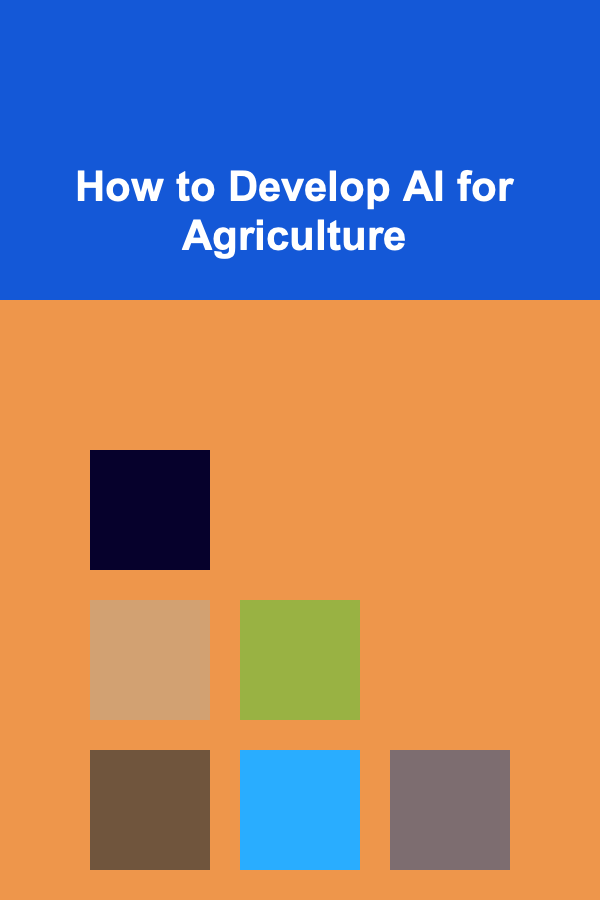
How to Develop AI for Agriculture
ebook include PDF & Audio bundle (Micro Guide)
$12.99$7.99
Limited Time Offer! Order within the next:

The development and integration of Artificial Intelligence (AI) in agriculture are transforming the way we approach food production and farming practices. As the global population continues to grow, the need for efficient, sustainable, and scalable agricultural practices has never been greater. AI is playing a crucial role in addressing these challenges by optimizing farming techniques, increasing crop yields, reducing environmental impact, and improving overall efficiency. In this article, we will explore how to develop AI for agriculture, the technologies involved, the challenges faced, and the potential benefits that AI brings to the agricultural sector.
Introduction to AI in Agriculture
Artificial Intelligence (AI) refers to the ability of machines and computer systems to perform tasks that typically require human intelligence. These tasks include problem-solving, decision-making, pattern recognition, and learning from experience. In agriculture, AI technologies are used to analyze data, predict outcomes, automate processes, and assist in decision-making. The goal is to enhance productivity, reduce resource consumption, and improve the sustainability of farming operations.
AI applications in agriculture span a variety of areas, such as precision farming, crop management, pest and disease detection, autonomous machinery, supply chain optimization, and environmental monitoring. With the global demand for food expected to rise by 60% by 2050, AI holds immense potential in transforming agriculture into a more efficient, sustainable, and data-driven industry.
Key Technologies in AI for Agriculture
Developing AI for agriculture involves the use of several cutting-edge technologies. These technologies enable farmers to leverage data-driven insights to make better decisions, optimize their operations, and improve crop yields. Below are some of the key AI technologies used in agriculture:
1. Machine Learning (ML)
Machine learning, a subset of AI, is one of the most important technologies used in agriculture. ML algorithms enable machines to analyze data, recognize patterns, and learn from experience without explicit programming. In agriculture, ML is used for various applications, such as:
- Crop Prediction: Machine learning models can predict crop yields based on historical data, weather patterns, soil conditions, and other variables. This helps farmers plan their harvests more effectively and reduce waste.
- Soil Health Monitoring: ML models can analyze soil samples and identify patterns in soil quality, enabling farmers to make informed decisions on fertilization and irrigation.
- Precision Irrigation: Machine learning models can optimize irrigation schedules by analyzing weather forecasts, soil moisture levels, and crop needs. This reduces water waste and ensures that crops receive the right amount of water.
2. Computer Vision
Computer vision is a technology that enables machines to interpret and understand visual information from the world around them. In agriculture, computer vision is used to monitor crops, detect diseases, and identify pests. Through the use of cameras, drones, and satellite imagery, AI systems can analyze images and provide valuable insights. Common applications of computer vision in agriculture include:
- Pest and Disease Detection: Computer vision systems can analyze images of plants and detect early signs of diseases or pest infestations. By identifying these issues early, farmers can take timely action to prevent crop loss.
- Weed Identification: AI-powered computer vision systems can differentiate between crops and weeds, allowing for precise herbicide application. This reduces chemical use and minimizes environmental impact.
- Harvesting Robots: Computer vision helps autonomous harvesting robots identify ripe fruits or vegetables and harvest them efficiently. This reduces labor costs and increases the speed of harvests.
3. Robotics and Autonomous Machines
Robotics is another technology that is revolutionizing the agricultural sector. Autonomous machines, such as drones, robots, and self-driving tractors, are becoming increasingly common in modern farms. These machines are equipped with AI algorithms and sensors to perform tasks such as planting, watering, fertilizing, and harvesting crops. Some key applications of robotics in agriculture include:
- Autonomous Tractors: Self-driving tractors equipped with GPS, sensors, and AI algorithms can plow fields, plant seeds, and perform other tasks with minimal human intervention. These machines increase efficiency and reduce the need for labor.
- Drones: Drones are widely used for aerial surveillance and crop monitoring. They can capture high-resolution images of fields, assess crop health, and detect pest or disease problems. Drones can also be used to apply pesticides or fertilizers precisely.
- Robotic Harvesters: AI-powered robots are being developed to harvest crops with high precision. These robots can identify ripe produce, pick them carefully, and minimize damage to crops, all while reducing labor costs.
4. Internet of Things (IoT)
The Internet of Things (IoT) refers to the network of physical devices connected to the internet, allowing them to collect and exchange data. In agriculture, IoT devices such as sensors, GPS trackers, and weather stations are used to monitor various factors that affect crop growth, such as soil moisture, temperature, humidity, and light levels. IoT devices collect real-time data that can be analyzed by AI algorithms to make informed decisions. Applications of IoT in agriculture include:
- Precision Agriculture: IoT sensors placed in the soil or on crops can provide real-time data on environmental conditions. This data can be used by AI systems to optimize irrigation, fertilization, and pest management.
- Livestock Monitoring: IoT devices can be used to monitor the health and well-being of livestock. Sensors can track vital signs such as heart rate, temperature, and activity levels, helping farmers detect diseases early and manage their herds more efficiently.
5. Big Data and Analytics
Agriculture generates vast amounts of data, from weather patterns to soil conditions to market prices. AI relies on big data analytics to process and analyze this information to gain valuable insights. By using advanced algorithms, AI can identify trends, make predictions, and provide recommendations for improving farming practices. Some key applications of big data and analytics in agriculture include:
- Yield Prediction: AI can analyze historical yield data and environmental factors to predict future crop yields. This helps farmers optimize planting schedules and make better decisions about resource allocation.
- Supply Chain Optimization: Big data analytics can help optimize the agricultural supply chain by predicting demand, managing inventory, and identifying the most efficient transportation routes.
- Market Analysis: AI can analyze market trends and consumer preferences, helping farmers make informed decisions about which crops to grow and when to sell them.
Developing AI for Agriculture: Key Steps
Developing AI solutions for agriculture requires a multi-disciplinary approach that combines expertise in AI, agriculture, data science, and engineering. Below are the key steps involved in the development of AI for agriculture:
1. Identifying the Problem
The first step in developing AI for agriculture is to identify the specific problem you want to solve. This could be improving crop yields, reducing water usage, managing pests and diseases, or optimizing the supply chain. Understanding the challenges faced by farmers is essential to developing an AI solution that addresses real-world needs.
2. Collecting and Preprocessing Data
AI systems rely on data to learn and make predictions. In agriculture, data can come from various sources, such as sensors, drones, satellites, and historical records. It is important to collect high-quality data and preprocess it to ensure that it is clean, accurate, and relevant. Data preprocessing may involve:
- Cleaning: Removing any noise or irrelevant data.
- Normalization: Ensuring that all data is on the same scale.
- Feature Extraction: Identifying the most important variables that will help the AI model make accurate predictions.
3. Choosing the Right AI Model
The next step is to choose the right AI model for the problem at hand. Different AI techniques, such as machine learning, deep learning, and reinforcement learning, can be used depending on the complexity of the task. For example:
- Supervised Learning: Used for tasks such as crop classification and yield prediction, where labeled data is available.
- Unsupervised Learning: Used for tasks like clustering or anomaly detection, where labeled data is not available.
- Reinforcement Learning: Used for tasks like optimizing irrigation or pest control, where the AI system learns through trial and error.
4. Training and Testing the Model
Once the AI model has been selected, it must be trained on the collected data. This involves feeding the data into the model and allowing it to learn patterns and relationships. The model is then tested to evaluate its performance and accuracy. If the model's performance is not satisfactory, adjustments may be made to improve it, such as:
- Tuning Hyperparameters: Adjusting the settings of the AI model to optimize performance.
- Feature Engineering: Adding or removing features that improve the model's accuracy.
- Increasing Data: Collecting more data to help the model learn better patterns.
5. Deploying the AI System
After the AI model has been trained and tested, it can be deployed in the field. This may involve integrating the model into agricultural equipment, such as drones, robots, or tractors, or developing a software platform for farmers to access AI-driven insights. Deployment also requires ongoing monitoring and maintenance to ensure the system remains effective as conditions change over time.
Challenges in Developing AI for Agriculture
Despite the promising potential of AI in agriculture, there are several challenges that developers and farmers face:
- Data Quality and Availability: High-quality data is essential for training AI models, but in many regions, data collection is limited, especially in small-scale farming operations.
- Cost of Technology: The cost of implementing AI-powered solutions, such as drones, sensors, and autonomous machines, can be prohibitively expensive for small farmers.
- Complexity of Agricultural Systems: Agricultural systems are highly complex and vary from region to region. Developing AI models that can adapt to different environments and farming practices is a significant challenge.
- Integration with Existing Infrastructure: Many farms rely on traditional methods and equipment. Integrating AI solutions with existing infrastructure can be difficult and costly.
Conclusion
Developing AI for agriculture is a complex but rewarding endeavor. With the right combination of technologies, expertise, and data, AI can revolutionize the agricultural industry, making farming more efficient, sustainable, and productive. As AI continues to advance, we can expect to see even greater innovations in crop management, precision farming, autonomous machinery, and environmental monitoring. However, to fully realize the potential of AI in agriculture, it is essential to address the challenges of data quality, cost, and integration, ensuring that AI solutions are accessible and beneficial to all farmers.

How to Achieve a Rustic Lighting Look in Your Home
Read More
How to Make Smart Investment Decisions During Market Volatility
Read More
How to Store Shoes Efficiently in a Small Home
Read More
How to Write a Compelling Grant Proposal for Social Services
Read More
How to Pack a Picnic for Dietary Restrictions
Read More
10 Tips for Scoring Tickets to Sold-Out Sporting Events
Read MoreOther Products

How to Achieve a Rustic Lighting Look in Your Home
Read More
How to Make Smart Investment Decisions During Market Volatility
Read More
How to Store Shoes Efficiently in a Small Home
Read More
How to Write a Compelling Grant Proposal for Social Services
Read More
How to Pack a Picnic for Dietary Restrictions
Read More